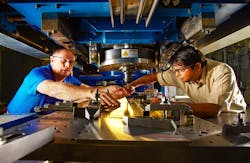National Labs Focus on Cutting Weight in Cars and Trucks
The lighter the vehicle, the farther it travels on a gallon of fuel. That’s the driver behind four new projects designed to reducing the weight of vehicle components. The projects are being conducted under the auspices of the Department of Energy’s (DOE) Lightweight Materials Consortium, or LightMAT.
DOE will provide funding and technical assistance to industry partners who will match the DOE funding. “LightMAT will let DOE’s national laboratories assist industry with fundamental scientific research that will make even lighter vehicles possible,” says LightMAT Director Darrell Herling, who is also an engineer at the Pacific Northwest National Laboratory. “We asked industry applicants to bring us their biggest technical challenges in implementing lightweight materials, and we’ll bring the right capabilities and knowhow—not available outside the national lab system—to bear on the problem.”
If lighter materials can be energy-efficiently and economical, it will speed up their adoption into vehicles. Industrial partners will apply and test approaches developed in these projects. Ultimately, as global-suppliers, they will be able to provide lightweight components to several automakers while generally increasing U.S. manufacturing competitiveness.
The four teams will tackle the following technical challenges:
Lightweight brakes. Arconic (an engineered material supplier) and PNNL will partner to develop a metal-ceramic composite brake. PNNL has experience in metal-matrix composites, which are stronger and more rigid than metal alloys. PNNL researchers will use a research-scale mixing process to make composites, then evaluate the resulting materials for strength and wear resistance. Replacing current cast-iron brake components with versions made from a composite will reduce vehicle weight, and could improve braking performance.
Carbon coating. ArcelorMittal (a steel company) and Diversitak (a Detroit-based automotive polymer company) will team with experts from Oak Ridge and Idaho National Laboratories to reinforce thin sheets of high-strength steel with a carbon-fiber-epoxy coating, and then test it as a component coating. High-strength steel can be made into thin, lightweight panels, but they lack the stiffness needed for auto parts. It is hoped the epoxy coating will supply the necessary stiffness. ORNL’s carbon materials expertise and INL’s chemistry, metallography, and high-resolution imaging capability will help the team partners develop the coating, while ensuring the integrity of the interface between the coating and steel.
Reduced magnesium corrosion. The Magna-Stronach Centre of Innovation (a global automotive supplier) and PNNL will partner to develop ways to join magnesium—the lightest structural metal, and among the newest materials used in vehicles—to other dissimilar metals, while simultaneously mitigating corrosion. Magnesium parts would ideally be bolted or welded to another parts such as interior door beams. But magnesium interacts with most other metals in the presence of water in any form to cause corrosion. PNNL researchers will try to manipulate the chemistry of magnesium to make it less corrosive. The aim is to develop specialized isolating barriers to put between magnesium and the other metals to make lightweight, corrosion-resistant components and smooth body panels.
Tooling for extruding alloys. Sapa Technology, the R&D arm of Sapa Group, a global aluminum company, will work with PNNL to come up with a more cost-effective way to make extruded components out of strong aluminum alloys. It is difficult to extrude such parts at high rates and volumes using current methods, plus the extrusion tooling wears out quickly. PNNL’s metallurgical expertise will help improve the tooling and extrusion process to make it faster and cheaper. Researchers will also use data collected from observing interactions between aluminum and steel at the atomic level using PNNL’s electron microscopes.


